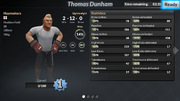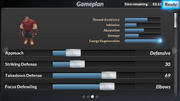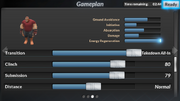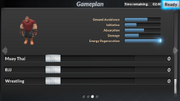Fights in MMA Manager are matches between two fighters from different gyms.
Fight modes[ | ]
Quick fights[ | ]
Quick fights are a multiplayer mode that pits a couple of players against each other in isolated matches.
Campaign[ | ]
Campaign is the game's single player mode, offering rewards for matches against fighters from various predefined gyms, each one ending in a boss fight.
Wins, losses, and draws from campaign fights are not recorded in a fighter's fight statistics.
Tournament[ | ]
A multiplayer mode where player's compete in an tournament-style competition.
Gym vs Gym[ | ]
A multiplayer mode that pits the fighters of two gyms against each other.
Pre-fight[ | ]

Before a fight begins, managers have the chance of viewing their opponent's vitals and statistics. Once the manager selects Fight and chooses a fighter, there is a limited time available for the manager to adjust the fighter's gameplan. Talents are also accessible at this time.
Gameplan[ | ]
The fighter's gameplan is the tactics he or she will use in a fight. The fighter's preferred, or default, gameplan can be set in the roster menu while at the gym, but the pre-fight gives a manager a chance to try to tailor the gameplan to the opponent. The fight statistics should offer some clue as to the opponent's strengths and weaknesses, though if the opponent hasn't been in fights yet, these stats will be a blank slate. Gameplans are divided into four pages which are scrolled between by swiping up and down.
First page[ | ]

- Approach: there are five options.
- Very Defensive: Greatly reduce all damage taken and given, also gives away a lot of initiative to the opponent.
- Defensive: Increases defense for strikes and takedown but also decreases outgoing damage and initiative.
- Balanced: A Balanced approach, does not trade any defense for attack or the other way around.
- Offensive: Increases combo chance, initiative, and damage output but also increases vulnerability to takedown and strikes.
- Offensive All-In: Increased initiative and damage. This aggressive style reduces energy regeneration and increases vulnerability to takedowns.
- Striking Defense: Decreases incoming damage in a trade-off for less initiative.
- Takedown Defense: Increases defense against takedowns, but decreases initiative a lot.
- Focus Defending: there are seven options.
- Low Kicks: With increased preparation and focus you have reduced chance of being hit by Low Kicks and eliminates some of the damage potential.
- Knees: Increase avoidance of Knees and also reduces damage taken by being more prepared.
- High Kicks: Reduces damage and chance of being hit by High Kicks.
- Boxing: Reduces damage and chance of being hit by Punches.
- Elbows: Reduces damage and change of being struck by Elbows.
- Balanced: A balanced defense that increases defenses to all attacks by a small margin. Equally effective but not dedicated to one type of attack.
- Submission: Be more prepared defending Submissions. Slightly increases chance of defending Submissions.
Second page[ | ]

- Punches: How often punches are performed.
- Low Kicks: How often low kicks are performed.
- Knees: How often knee attacks are performed.
- Elbows: How often elbow strikes are performed.
- High Kicks: How often high kicks are performed.
Third page[ | ]

- Transition: there are four options.
- Get off the ground: Prioritise escapes and transitions off the ground.
- Neutral: An adaptive strategy where the fighter adapts to the position it's in, standing is the default.
- Takedown: Preference for takedown attempts.
- Takedown All-In: Desperate times call for desperate measures. Drains more energy but increases the chance of going to the ground.
- Clinch: Beneficial strategy for fighters with strong wrestling and close combat skills.
- Submission: Fight to submission with grappling, locks, and choke holds. This strategy suits a strong wrestler, with adequate submission skills.
- Distance: There are three options.
- Distance: Beneficial strategy for fighters who need to stand up to deliver hard kicks.
- Normal: A more aggressive style than the distance strategy.
- Ground n Pound: Seek opportunities for takedowns and ground strikes. Stay in dominant positions and strike.
Fourth page[ | ]

- Muay Thai: Stand-up striking along with various clinching techniques. Great for performing knee and elbow strikes.
- BJJ: Focused on submissions, grappling, and ground fighting.
- Wrestling: Clinch fighting, grappling, throws, and takedowns. Combine wrestling with Ground n Pound or BJJ depending on what type of finishing method is preferred.
Fight[ | ]
Once a round begins, it is all up to the fighters to execute their gameplans and hopefully defeat their opponent. Managers can only sit back and watch during a round.
| This article is a stub. You can help MMA Manager Wiki by expanding it. |
